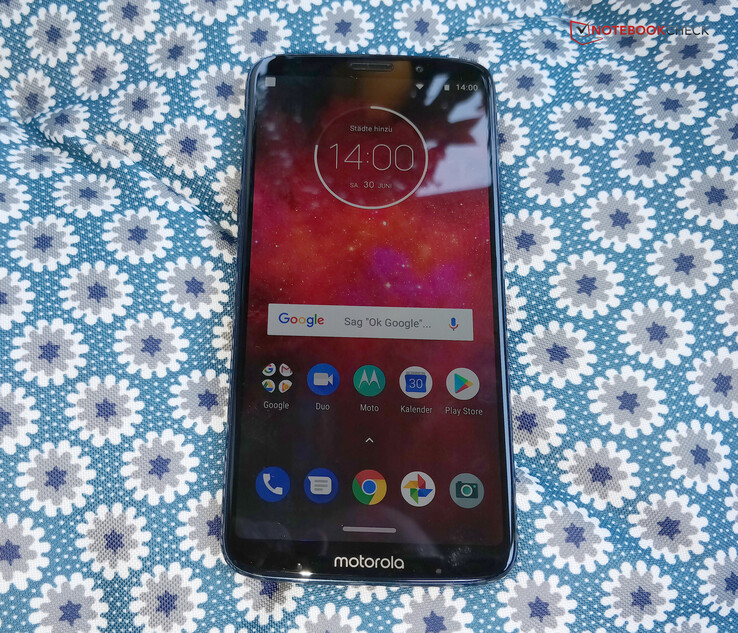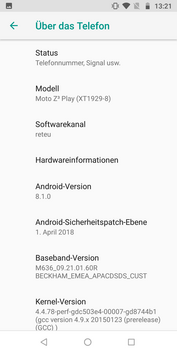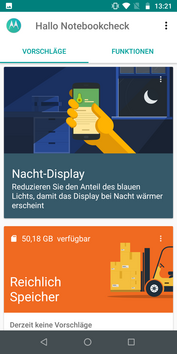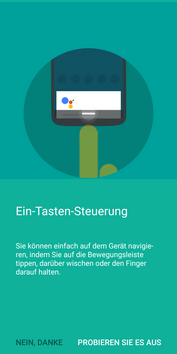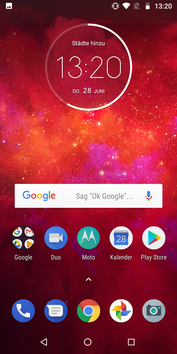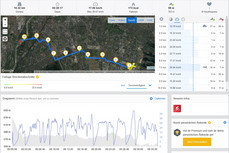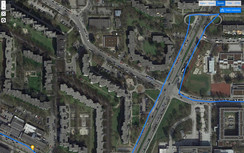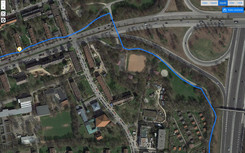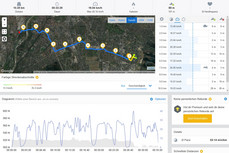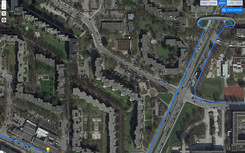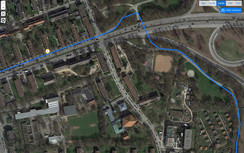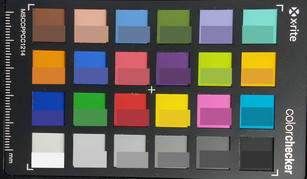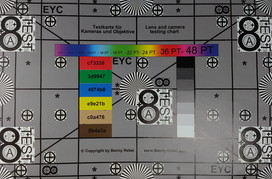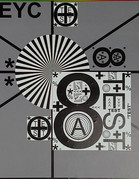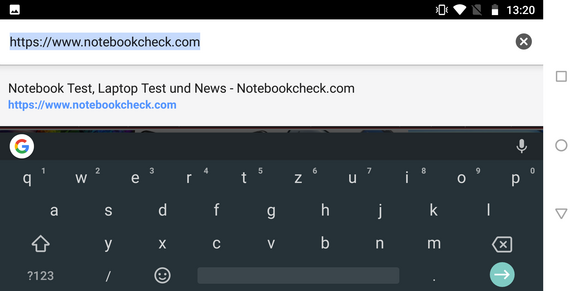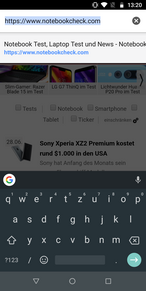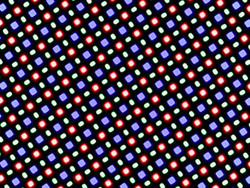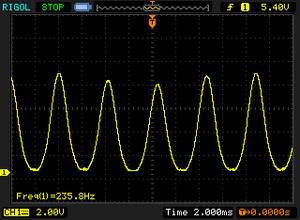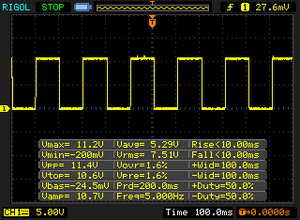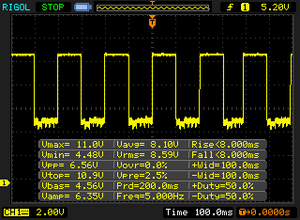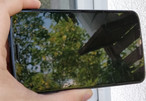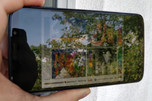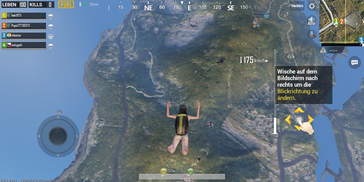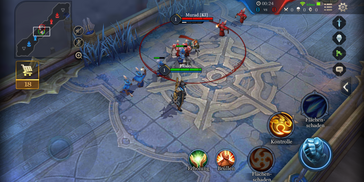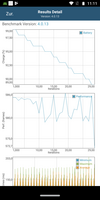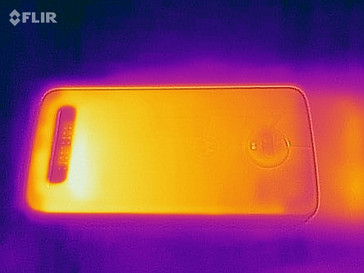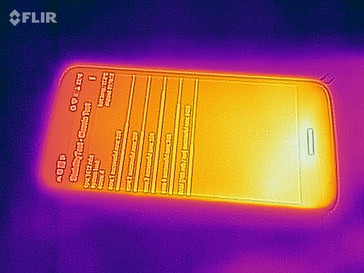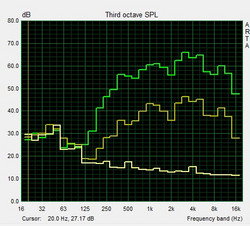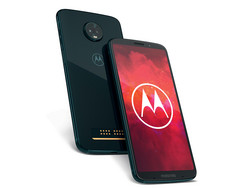Motorola Moto Z3 Play Smartphone Review
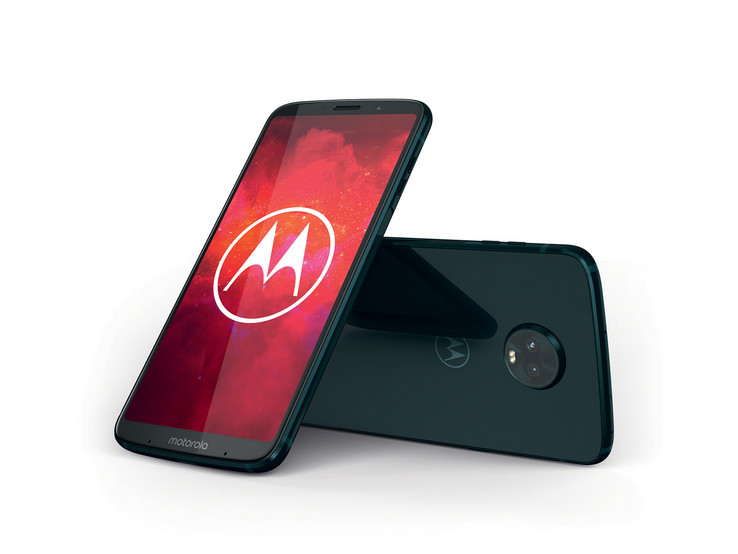
A possible high-end Moto Z3 smartphone is still not in sight, but at least the mid-range model of Motorola's modular smartphone series is now available: The Motorola Moto Z3 Play is again a very slim phone, now coming with a modern 2:1 display and narrow bezels. The fingerprint sensor has been moved to the side and various Moto Mods can be attached to the rear to augment the smartphone with several new features. For instance, the battery runtime can be increased, or a better camera module or a more powerful speaker can be attached. Together with a battery mod included in the box, the official price for the Moto Z3 Play is 499 Euros (~$582).
After the release of the Moto Z2 Play, we wished for more courageous additions to this series. Let us find out if this new device is any different.
No other manufacturer currently has a comparable concept of interchangeable mods, but there are still several good comparison devices: Other than the predecessor Motorola Moto Z2 Play, these include the OnePlus 6, which delivers high-end performance for a similar entry-level price, and the Huawei P20, which is also available for around 500 Euros (~$584) by now. The Honor 10 delivers high-end performance at an even lower price. As a classic mid-range model, the Nokia 7 Plus also deserves its spot among the competitors.
Case - Flat Glass Case for the Moto Z3 Play
The case of the Moto Z3 Play is slightly thicker than it was for the predecessor. At 6.75 millimeters, it is still one of the slimmest smartphones available, though. The camera module does not fit into such a slim case, so it protrudes quite a bit. At 156 grams, the Moto Z3 Play also gained some weight, but it remains one of the lighter smartphones of its size class. A modern 2:1 display format allows for narrow bezels at the top and bottom, but the bezels at the sides are still clearly visible. The 2.5D glass at the front and back of the case is new, resulting in a modern appearance that supposedly also leads to an improved received signal quality for the antennas in comparison to the predecessor's metal case. Currently, the only color option available for the Moto Z3 Play in Europe is a dark blue named Deep Indigo. Black variants of the Moto Z3 Play are available internationally, though.
The rear features a prominent port with 16 contact pins for the Moto Mods again. It remains to be seen whether the glass rear is able to withstand the module changes without any scratches in the long run. The case itself is rather robust, but it can be warped slightly under enough pressure. There is no creaking noise when that happens, though. The case can withstand pressure on the front and back. The smartphone's rear has slightly tangible edges, but other than that, the phone sits comfortably in the hand.
Connectivity - Motorola Smartphone without a Headphone Jack
This smartphone's only available variant in Europe comes with 64 GB of storage space and 4 GB of RAM. Variants with more and less memory are available in other regions of the world. A microSD card can be used to expand the storage, but the user has to sacrifice one of the two dual SIM slots in this case. The microSD card can be formatted as internal storage, but apps cannot be transferred to removable storage.
The 3.5 mm port, which was still available on the predecessor model, has been cut from this model. Instead, a USB-C-to-headphone adapter is included in the box. The USB-C port only works at USB 2.0 speed, but it is able to communicate with external storage media or charge other devices via USB OTG.
Software - Pure Android with Update Guarantee
Traditionally, Motorola uses a pure vanilla Android for its smartphones, as the American company used to belong to Google. The most recent Android version 8.1 is installed on the smartphone, with security patches from April 2018, which means they are tolerably up to date. Motorola promises an update for the security patches every 30 to 90 days. An update to Android P, the next-but-one Android version, will supposedly be delivered at a later point, too, but the technical requirements this update will place on the devices are so far unknown, so Motorola cannot provide a guarantee for this.
Motorola devices usually come with a low amount of preinstalled apps, which is another good tradition. The only apps installed on the Motorola Moto Z3 Play are the Moto App, which controls some additional software features, an app to select different backgrounds for the system, and the Moto Z Market, which offers an overview of the available Moto Mods and other accessories.
Communication and GPS - Finally ac Wi-Fi
The Motorola Moto Z3 Play supports 16 LTE bands, so it is still a reliable companion when traveling far abroad. The maximum LTE download speed is 600 Mb/s, while the maximum upload speed is 75 Mb/s. The Honor 10 and the OnePlus 6 offer far higher LTE speeds and the Moto Z3 Play's maximum upload speed is actually slower than the predecessor's. Using glass in the construction of current smartphones is supposed to ensure better reception. The Moto Z3 Play has at least acceptable reception. Inside a building within an urban area, the reception is decent.
The Wi-Fi is up to date, supporting 802.11 a/b/g/n/ac. Even the lesser crowded 5 GHz band is supported. The speeds we measured in our standardized test with the reference router Linksys EA8500 were slightly disappointing, though. In everyday use, websites also tend to load at a mediocre speed and the user has to wait for images to show. The reception is at full strength near the router, but at a distance of 10 meters and through three walls, the signal strength decreases by half and pages load even more slowly subjectively.
| Networking | |
| iperf3 transmit AX12 | |
| OnePlus 6 | |
| Huawei P20 | |
| Nokia 7 Plus | |
| Motorola Moto Z3 Play | |
| Honor 10 | |
| Lenovo Moto Z2 Play | |
| iperf3 receive AX12 | |
| Huawei P20 | |
| OnePlus 6 | |
| Nokia 7 Plus | |
| Motorola Moto Z3 Play | |
| Honor 10 | |
| Lenovo Moto Z2 Play | |
Even inside buildings, the GPS module is able to locate our position relatively well with an accuracy of 12 meters. Near a window, the accuracy increases to six meters and outdoors to about four meters. The localization in Google Maps works quickly and the compass shows our viewing direction rather precisely.
For our practical test, we took the Motorola Moto Z3 with us on a bike ride, alongside the professional navigation system Garmin Edge 520 as reference device. The track measured by the smartphone deviated by only 30 meters, which is a relatively good result. The Garmin Edge 520 was slightly more accurate in the area of the bridge with a curved ramp. Both devices had problems tracking our path near the underpass, but the professional navigation device was a bit more exact again. The Moto Z3 Play's localization abilities are good enough for a mid-range device, though, and it should be sufficient in most everyday situations.
Telephone Functions and Voice Quality - Motorola Smartphone with Good Voice Quality
In terms of phone app, Motorola uses the standard app integrated in Android. VoLTE and VoWiFi, meaning calls via LTE or Wi-Fi, are supported.
The Moto Z3 Play's earpiece can be turned to a rather high volume if so desired, so it can still be used in noisy environments. However, people standing nearby might be able to overhear the call at this volume level. The other call participant sounds somewhat far away and less present than with other smartphones, but at least there are no disruptive background noises. The microphone records our voice very well, though, no matter if we are talking loudly or quietly. In hands-free mode, our call partner seems much more present and can be heard loud and clear. However, the microphone records a lot of background noise in this mode, but it is still able to relay our voice clearly, regardless of if we are talking loudly or quietly.
Cameras - Mediocre Performance and 4K Videos
For the second time in the history of the Moto Z series, a dual camera system is installed in the circular camera module on the phone's rear - the Moto Z2 Force also had a double lens and a setup similar to that of the Moto Z3 Play: A 12-megapixel lens for the main work and a 5-megapixel camera as support. This allows the calculation of the depth of focus and objects can be cut automatically. However, the latter only works really well with a homogeneous, unicolored background.
The main camera's pictures show very vibrant colors and a good brightness, but very bright areas might exhibit too much bloom. The image sharpness is average, just like the performance in low-light conditions: The brightness is still okay, but at a closer look, objects appear slightly more out of focus than they do with the Apple iPhone X - but that costs almost twice as much. Given the price difference, the differences in image quality are actually rather small. 4K videos can be recorded at 30 fps, Full HD videos at 60 fps. The smartphone warms up slightly during a 4K recording, but that does not go as far as turning off due to overheating. The video quality is good: Details are high, but in opposite to photo mode, the colors could be a bit more vibrant. The exposure adjusts well to changes in light. Slow-motion videos can be recorded, but only in 720p. Afterwards, they can be decelerated partly or entirely via software use.
Motorola is one of the first manufacturers to integrate Google's new object recognition software Google Lens into the camera's software. As things stand at the moment, the recognition is still rather mediocre, but thanks to an adaptive KI, it might improve as soon as more people start using it. For now, the camera does well enough at reading text and subsequently searching for it on Google.
The front camera has a resolution of 8 megapixels. In terms of color, its pictures are relatively good, but brighter areas quickly lose detail. The level of detail in general is quite decent, but the image sharpness is not perfect.
Under controlled lighting conditions in our laboratory, the main camera is still slightly out of focus and also has some problems with text in front of colored areas. The photo was also slightly too dark, while the color representation tended to be slightly too bright but still good overall.
Accessories and Warranty - Moto Mod in the Box
Accessories are an especially interesting topic for Motorola's Z series with the existence of Moto Mods, which snap into place magnetically at the 16-pole docking connector on the back side of the device. Some information about this can already be found in our reviews for the Motorola Moto Z2 Play, the Moto Z2 Force, the Moto Z Play, and the Moto Z. We really liked that Motorola already ensured during the first generation that mods will be compatible with future generations as well, which is still true for the Moto Z3 Play. The mods have a tight and secure fit on the smartphone. A lot of different accessories are available as mods nowadays, such as additional speakers, simple style covers, batteries, and better cameras.
An additional battery in the form of a Moto Mod is included in the box. More precisely, the included battery is the small Power Pack with 2,220 mAh, but larger variants are available as well. This comparatively lightweight battery already reveals one of the system's flaws, though: The light and graceful Moto Z3 Play quickly turns into a massive and heavy smartphone after adding an accessory. The weight suddenly shoots up to 226 grams with an added battery, which is definitely something one has to get used to over time.
Additionally, a TurboPower charger is included as well. Motorola's own charging technology is based on QuickCharge, but fast charging is only possible with Motorola's power supplies. A simple headset (interestingly enough with a jack plug) and a USB-C-to-3.5mm adapter can also be found in the box.
Motorola has provided us with two Moto Mods for review: The Moto Insta Share printer and the Smart Speaker. The printer was developed and designed together with Polaroid, a name that instantly reveals what this Moto Mod is for: printing photos instantly. The Mod is clad in White and Light Grey on the outside with a small rainbow and an imprint below the camera module. The Mod is not its own camera but utilizes the smartphone’s camera instead, sends the photos to an app which then sends it to the printer. The photos are then printed with Zero Ink technology, ten pages of photo paper are included with the Mod. Every additional page will cost around 83 cents. Fully loaded with 10 pages the Moto Mod weighs exactly 200 g (7.05 oz). Printouts are 5 x 7.6 cm (1.97 x 2.99 inches) in size and are somewhat pale, depending on the filter chosen prior to printing. Truth be told they look like real Polaroids. The legendary Polaroid bezel is not printed on automatically and must be added via software prior to printing, which will however shrink the resulting photo somewhat. The Mod worked very reliably and printed very fast. It costs around $120 and thus at a price level similar to photo printers.
The other Moto Mod reviewed by us was the Moto Smart Speaker with Amazon Alexa. It transformed our Moto Z3 Play (or any other Moto Z series smartphone) into an Amazon Echo smart speaker. The only languages available so far are German, American English, British English, or Indian English. It also requires a SIM card to be installed in the phone, and the camera cannot be used with the speaker connected. The app was still marked as beta, but it worked very well in our tests save for one crash. Thanks to a small foot the phone will stand slightly angled when placed on a table. Voice recognition worked remarkable well, and the smartphone does not have to be unlocked for it to work. The Alexa app itself is usable even without the speaker as it only serves to improve sound performance. It offered a decent enough sound quality for small rooms, but at around $120 it is more expensive than an Amazon Alexa speaker.
Motorola offers a warranty of 24 months. Please see our Guarantees, Return policies and Warranties FAQ for country-specific information.
Input Devices & Operation - The Fingerprint Sensor Changed Places
Google's GBoard is used as the keyboard app, and it also includes a feature to use voice typing. Users can swipe their finger over the letters to write a word or directly search for a word or sentence on Google. The operation is easy thanks to many themes and settings.
Even though Motorola installed a mostly pure Android, the manufacturer made some adjustments especially for the operation of the device: As the fingerprint sensor has been moved to the right side of the case, it can no longer be used for gesture control of the Android menu. Motorola offers a replacement: In addition to using the normal menu buttons on the display, gesture control can be activated alternatively. It can be performed by swiping left or right or by pressing a single button at the lower part of the screen to trigger the desired features. This works rather intuitively, but it does not enable the expanded screen, which was another advantage of the operation via fingerprint sensor. The fingerprint sensor is rather convincing in general: It unlocks the smartphone quickly and reliably from standby mode, and it can easily be found by touch.
The fingerprint sensor's new position was chosen well, as it is just in the spot where the thumb is anyway for right-handed users. Left-handed users can use their forefinger instead, which also works relatively well. However, we did not like the position of the standby button very much: It has been placed directly opposite the fingerprint sensor on the left side of the case. This might be fine for left-handed users, but it is rather uncomfortable for right-handed users to send the smartphone into standby mode.
For those interested in using voice control, in addition to the Google Assistant, Motorola's own solution can now be used. It is able to understand natural language and does not have to be activated by a separate command every time and can instead listen permanently, if so desired. Supposedly, the transfer of commands to other apps should work as well, but it transferred wrong spellings in our test with Google Maps, even though Motorola Voice did understand us correctly. Given the fact that the version installed on our smartphone was only a beta release, improvements might be coming soon.
The standby display can be activated optionally when the phone detects movement. It shows the time and notifications. Using gestures, the phone can be muted and a one-handed mode with a downscaled display area can be activated.
Display - Good Color Space Coverage, Average Color Accuracy
Motorola equipped the Moto Z3 Play with an AMOLED display with a resolution of 2160x1080 pixels. At 452 cd/m², the screen's maximum brightness is good, but it is inferior to the Huawei P20, which has a much brighter LED display. The distribution of brightness is quite even at 93%, so that larger colored areas barely show any differences in brightness.
| |||||||||||||||||||||||||
Brightness Distribution: 93 %
Center on Battery: 239 cd/m²
Contrast: ∞:1 (Black: 0 cd/m²)
ΔE ColorChecker Calman: 6.58 | ∀{0.5-29.43 Ø4.79}
ΔE Greyscale Calman: 3.6 | ∀{0.09-98 Ø5}
147% sRGB (Calman 2D)
Gamma: 2.199
CCT: 7116 K
| Motorola Moto Z3 Play AMOLED, 2160x1080, 6" | OnePlus 6 Optic AMOLED, 2280x1080, 6.3" | Lenovo Moto Z2 Play AMOLED, 1920x1080, 5.5" | Honor 10 IPS, 2280x1080, 5.8" | Huawei P20 LTPS, 2240x1080, 5.8" | Nokia 7 Plus IPS, 2160x1080, 6" | |
|---|---|---|---|---|---|---|
| Screen | 24% | 3% | 25% | 59% | 9% | |
| Brightness middle (cd/m²) | 446 | 430 -4% | 434 -3% | 555 24% | 753 69% | 458 3% |
| Brightness (cd/m²) | 451 | 437 -3% | 404 -10% | 537 19% | 748 66% | 463 3% |
| Brightness Distribution (%) | 93 | 87 -6% | 81 -13% | 94 1% | 96 3% | 92 -1% |
| Black Level * (cd/m²) | 0.39 | 0.37 | 0.22 | |||
| Colorchecker dE 2000 * | 6.58 | 2.3 65% | 4.4 33% | 2.3 65% | 1.3 80% | 4 39% |
| Colorchecker dE 2000 max. * | 11.94 | 4.6 61% | 8.6 28% | 6 50% | 2.3 81% | 7.4 38% |
| Greyscale dE 2000 * | 3.6 | 2.4 33% | 4.2 -17% | 3.9 -8% | 1.7 53% | 4.7 -31% |
| Gamma | 2.199 100% | 2.28 96% | 2.24 98% | 2.19 100% | 2.18 101% | 2.19 100% |
| CCT | 7116 91% | 6160 106% | 7343 89% | 6212 105% | 66.76 9736% | 7425 88% |
| Contrast (:1) | 1423 | 2035 | 2082 |
* ... smaller is better
Screen Flickering / PWM (Pulse-Width Modulation)
| Screen flickering / PWM detected | 236 Hz | ||
The display backlight flickers at 236 Hz (worst case, e.g., utilizing PWM) . The frequency of 236 Hz is relatively low, so sensitive users will likely notice flickering and experience eyestrain at the stated brightness setting and below. In comparison: 53 % of all tested devices do not use PWM to dim the display. If PWM was detected, an average of 8156 (minimum: 5 - maximum: 343500) Hz was measured. | |||
Thanks to its AMOLED screen, the Motorola Moto Z3 Play is able to display absolute black, which in theory means an infinitely high contrast. Colors really look very vibrant on this display. Our measurements with a spectrophotometer and the CalMAN software showed a complete coverage of the sRGB color space. The AdobeRGB color space was covered by 93%. These values make the display suitable for more demanding activities, such as checking the colors in photos. However, the smartphone's color representation should be adjusted first because the standard settings (vibrant-neutral) show a slight blue tint and too much color saturation. The standard-neutral setting has a significantly better color accuracy, but the slight blue tint is still there.
Measurements with our oscilloscope show a distinct flickering. Sensitive users should check out the display before purchasing the smartphone.
Display Response Times
| ↔ Response Time Black to White | ||
|---|---|---|
| 20 ms ... rise ↗ and fall ↘ combined | ↗ 10 ms rise | |
| ↘ 10 ms fall | ||
| The screen shows good response rates in our tests, but may be too slow for competitive gamers. In comparison, all tested devices range from 0.1 (minimum) to 240 (maximum) ms. » 42 % of all devices are better. This means that the measured response time is similar to the average of all tested devices (20.3 ms). | ||
| ↔ Response Time 50% Grey to 80% Grey | ||
| 16 ms ... rise ↗ and fall ↘ combined | ↗ 8 ms rise | |
| ↘ 8 ms fall | ||
| The screen shows good response rates in our tests, but may be too slow for competitive gamers. In comparison, all tested devices range from 0.165 (minimum) to 636 (maximum) ms. » 29 % of all devices are better. This means that the measured response time is better than the average of all tested devices (31.7 ms). | ||
We already noticed during our measurements in the laboratory that the brightness sensor leads to a far lower brightness than manually adjusting the brightness does. This difference is noticeable outdoors, but less so than the measurements suggested. Overall, this smartphone is definitely suitable for outdoor use, but reflections on the screen might pose a problem and the brightness has to be set to high values in brighter environments.
The viewing angles are flawless: The screen content can be seen easily even at flat angles.
Performance - Latest Snapdragon with Good Performance
The Moto Z3 Play is equipped with Qualcomm's cutting-edge mid-range SoC Snapdragon 636, which we already took a look at in the Xiaomi Redmi Note 5. The Moto Z3 Play clearly leaves behind its predecessor, but it cannot compare to high-end devices such as the Honor 10 and the OnePlus 6. We did not notice any stutters in everyday use. Even with several apps running in the background, browsing the menus worked smoothly.
The graphics acceleration is powered by a Qualcomm Adreno 509, which is also much faster than the predecessor's graphics solution, but not on a par with the other comparison devices.
| AnTuTu v6 - Total Score (sort by value) | |
| Motorola Moto Z3 Play | |
| OnePlus 6 | |
| Lenovo Moto Z2 Play | |
| Honor 10 | |
| Huawei P20 | |
| Nokia 7 Plus | |
| Average Qualcomm Snapdragon 636 (92015 - 125213, n=10) | |
| AnTuTu v7 - Total Score (sort by value) | |
| Motorola Moto Z3 Play | |
| OnePlus 6 | |
| Honor 10 | |
| Huawei P20 | |
| Nokia 7 Plus | |
| Average Qualcomm Snapdragon 636 (115565 - 138661, n=11) | |
| PCMark for Android | |
| Work performance score (sort by value) | |
| Motorola Moto Z3 Play | |
| OnePlus 6 | |
| Lenovo Moto Z2 Play | |
| Honor 10 | |
| Huawei P20 | |
| Nokia 7 Plus | |
| Average Qualcomm Snapdragon 636 (6040 - 7618, n=11) | |
| Work 2.0 performance score (sort by value) | |
| Motorola Moto Z3 Play | |
| OnePlus 6 | |
| Lenovo Moto Z2 Play | |
| Honor 10 | |
| Huawei P20 | |
| Nokia 7 Plus | |
| Average Qualcomm Snapdragon 636 (5611 - 6277, n=11) | |
| GFXBench 3.1 | |
| on screen Manhattan ES 3.1 Onscreen (sort by value) | |
| Motorola Moto Z3 Play | |
| OnePlus 6 | |
| Lenovo Moto Z2 Play | |
| Honor 10 | |
| Huawei P20 | |
| Nokia 7 Plus | |
| Average Qualcomm Snapdragon 636 (5.7 - 12, n=12) | |
| Average of class Smartphone (11 - 166, n=158, last 2 years) | |
| 1920x1080 Manhattan ES 3.1 Offscreen (sort by value) | |
| Motorola Moto Z3 Play | |
| OnePlus 6 | |
| Lenovo Moto Z2 Play | |
| Honor 10 | |
| Huawei P20 | |
| Nokia 7 Plus | |
| Average Qualcomm Snapdragon 636 (6.3 - 10, n=12) | |
| Average of class Smartphone (8.4 - 413, n=157, last 2 years) | |
As mentioned previously in the section about communication, browsing the web is not one of the Moto Z3 Play's strong points because websites load slowly. This is also noticeable in the benchmarks: There is a clear speed boost in comparison to the Moto Z2 Play, but other devices render websites much faster. More-demanding HTML 5 applications such as Google's Interland stutter noticeably.
| JetStream 1.1 - Total Score | |
| OnePlus 6 (Chrome 66) | |
| Honor 10 (Chrome 66) | |
| Huawei P20 (Chrome 66.0.3359.126) | |
| Nokia 7 Plus (Chrome 60) | |
| Average Qualcomm Snapdragon 636 (44.2 - 51.5, n=11) | |
| Motorola Moto Z3 Play (Chrome 67) | |
| Lenovo Moto Z2 Play (Chrome 59) | |
| Octane V2 - Total Score | |
| Average of class Smartphone (2228 - 121337, n=201, last 2 years) | |
| OnePlus 6 (Chrome 66) | |
| Huawei P20 (Chrome 66.0.3359.126) | |
| Honor 10 (Chrome 66) | |
| Nokia 7 Plus (Chrome 60) | |
| Average Qualcomm Snapdragon 636 (8163 - 9746, n=12) | |
| Motorola Moto Z3 Play (Chrome 67) | |
| Lenovo Moto Z2 Play (Chrome 59) | |
| Mozilla Kraken 1.1 - Total | |
| Lenovo Moto Z2 Play (Chrome 59) | |
| Motorola Moto Z3 Play (Chrome 67) | |
| Average Qualcomm Snapdragon 636 (4105 - 5066, n=12) | |
| Huawei P20 (Chrome 66.0.3359.126) | |
| Nokia 7 Plus (Chrome 60) | |
| Honor 10 (Chrome 66) | |
| OnePlus 6 (Chrome 66) | |
| Average of class Smartphone (257 - 28190, n=156, last 2 years) | |
| WebXPRT 2015 - Overall | |
| OnePlus 6 (Chrome 66) | |
| Huawei P20 (Chrome 66.0.3359.126) | |
| Honor 10 (Chrome 66) | |
| Nokia 7 Plus (Chrome 60) | |
| Average Qualcomm Snapdragon 636 (147 - 184, n=8) | |
| Motorola Moto Z3 Play | |
| Lenovo Moto Z2 Play (Chrome 59) | |
* ... smaller is better
In terms of memory access, the Moto Z3 Play is much faster than its predecessor again, but other devices with UFS are miles ahead. The Moto smartphone performed decently when accessing our reference microSD card Toshiba Exceria Pro M501. In fact, with a look at our table, it seems to be a special feature to be able to expand the storage at all.
| Motorola Moto Z3 Play | OnePlus 6 | Lenovo Moto Z2 Play | Honor 10 | Huawei P20 | Nokia 7 Plus | Average 64 GB UFS 2.0 Flash | Average of class Smartphone | |
|---|---|---|---|---|---|---|---|---|
| AndroBench 3-5 | 57% | -21% | 111% | 111% | -12% | 25% | 576% | |
| Sequential Read 256KB (MB/s) | 271.7 | 726 167% | 245.6 -10% | 828 205% | 827 204% | 283.1 4% | 513 ? 89% | 2212 ? 714% |
| Sequential Write 256KB (MB/s) | 182.5 | 201.4 10% | 137.5 -25% | 192.1 5% | 193.6 6% | 211.6 16% | 175.2 ? -4% | 1835 ? 905% |
| Random Read 4KB (MB/s) | 60.6 | 137 126% | 38.2 -37% | 145.9 141% | 147 143% | 54.7 -10% | 117.1 ? 93% | 293 ? 383% |
| Random Write 4KB (MB/s) | 84.1 | 21.8 -74% | 47.9 -43% | 163 94% | 161.5 92% | 19.62 -77% | 81.1 ? -4% | 338 ? 302% |
| Sequential Read 256KB SDCard (MB/s) | 83.7 | 79.7 ? -5% | 82.2 -2% | 73.4 ? -12% | ||||
| Sequential Write 256KB SDCard (MB/s) | 62.7 | 58.7 ? -6% | 62.3 -1% | 55.4 ? -12% |
Games – 60 fps Gaming Possible to Some Extent
The smartphone does well with more complex games such as Arena of Valor even in 60 fps mode. However, games that really push the hardware, such as PUBG Mobile, cannot be displayed fluently at high details and they show fps drops repeatedly. The game no longer poses a problem at low settings, but it cannot be played with 60 fps on the Moto Z3 Play.
For users who are not planning to download the most recent smartphone games, the Moto Z3 Play should be sufficient. Users with higher demands will have to choose the OnePlus 6 or an even more expensive device.
The Moto Z3 Play does a great job with controls via touchscreen and position sensor, though: Everything works precisely and quickly.
| Arena of Valor | |||
| Settings | Value | ||
| min | 59 fps | ||
| high HD | 59 fps | ||
| PUBG Mobile | |||
| Settings | Value | ||
| Smooth | 30 fps | ||
| HD | 30 fps | ||
Emissions – Warm Case, Good Speaker
Temperature
The case of the Moto Z3 Play warms up to a maximum of 38.7 °C on the rear. For such a slim device, this value is quite good. The temperature rise is noticeable but not critical, and it is locally restricted.
GFXBench's battery test Manhattan 3.1 proves that the Motorola smartphone is able to keep up its performance even under a protracted load: There are no major frame rate differences between the first and the 30th iteration.
(+) The maximum temperature on the upper side is 36.8 °C / 98 F, compared to the average of 35.2 °C / 95 F, ranging from 21.9 to 247 °C for the class Smartphone.
(+) The bottom heats up to a maximum of 38.7 °C / 102 F, compared to the average of 34 °C / 93 F
(+) In idle usage, the average temperature for the upper side is 29.3 °C / 85 F, compared to the device average of 32.9 °C / 91 F.
Speakers
The Moto Z3 Play's front-pointing speaker sits at the position of the earpiece inside the case. This is a good position and the sound is quite decent as well. The speaker does not have a very high volume, but the sound is rather balanced. The highs are barely overemphasized and some lower mids can be heard. The speaker is sufficient for the occasional song or video, but more-demanding users might want to use USB- or jack plug headphones instead. A USB-C-to-3.5 mm adapter is included, as the smartphone does not have an audio jack. The sound transmission is good, as it is also via Bluetooth.
Motorola Moto Z3 Play audio analysis
(±) | speaker loudness is average but good (73.4 dB)
Bass 100 - 315 Hz
(-) | nearly no bass - on average 20% lower than median
(±) | linearity of bass is average (11.1% delta to prev. frequency)
Mids 400 - 2000 Hz
(+) | balanced mids - only 2.1% away from median
(+) | mids are linear (6% delta to prev. frequency)
Highs 2 - 16 kHz
(±) | higher highs - on average 5.3% higher than median
(±) | linearity of highs is average (8.9% delta to prev. frequency)
Overall 100 - 16.000 Hz
(±) | linearity of overall sound is average (22.1% difference to median)
Compared to same class
» 45% of all tested devices in this class were better, 7% similar, 48% worse
» The best had a delta of 11%, average was 35%, worst was 134%
Compared to all devices tested
» 63% of all tested devices were better, 6% similar, 31% worse
» The best had a delta of 4%, average was 24%, worst was 134%
Lenovo Moto Z2 Play audio analysis
(+) | speakers can play relatively loud (86.8 dB)
Bass 100 - 315 Hz
(-) | nearly no bass - on average 30.9% lower than median
(±) | linearity of bass is average (9.6% delta to prev. frequency)
Mids 400 - 2000 Hz
(+) | balanced mids - only 4.9% away from median
(+) | mids are linear (5.3% delta to prev. frequency)
Highs 2 - 16 kHz
(+) | balanced highs - only 1.9% away from median
(+) | highs are linear (3.6% delta to prev. frequency)
Overall 100 - 16.000 Hz
(±) | linearity of overall sound is average (19.3% difference to median)
Compared to same class
» 25% of all tested devices in this class were better, 9% similar, 66% worse
» The best had a delta of 11%, average was 35%, worst was 134%
Compared to all devices tested
» 45% of all tested devices were better, 8% similar, 47% worse
» The best had a delta of 4%, average was 24%, worst was 134%
Battery Runtime - High Power Consumption of the Motorola Moto Z3 Play
Power Consumption
In terms of power consumption, the Moto Z3 Play cannot compete with its predecessor Moto Z2 Play: Even while idling, it has a significantly higher consumption than its predecessor. In general, its idle consumption values are rather high. The power consumption in standby mode is also relatively high at 1 watt, but this can be easily explained by the info display popping up repeatedly. It can be deactivated to lower the power consumption in standby mode.
Under load, the power consumption is also higher than it was for the predecessor, but at least it is still considerably lower than for high-end devices.
| Off / Standby | |
| Idle | |
| Load |
|
Key:
min: | |
| Motorola Moto Z3 Play 3000 mAh | OnePlus 6 3300 mAh | Lenovo Moto Z2 Play 3000 mAh | Honor 10 3400 mAh | Huawei P20 3400 mAh | Nokia 7 Plus 3800 mAh | Average Qualcomm Snapdragon 636 | Average of class Smartphone | |
|---|---|---|---|---|---|---|---|---|
| Power Consumption | 12% | 55% | -16% | -12% | -1% | -9% | -22% | |
| Idle Minimum * (Watt) | 1.3 | 0.6 54% | 0.45 65% | 1.12 14% | 0.67 48% | 0.65 50% | 0.944 ? 27% | 0.853 ? 34% |
| Idle Average * (Watt) | 2 | 1 50% | 0.78 61% | 2.26 -13% | 2.05 -3% | 1.76 12% | 2.22 ? -11% | 1.43 ? 28% |
| Idle Maximum * (Watt) | 2.7 | 1.6 41% | 0.84 69% | 2.3 15% | 2.11 22% | 1.78 34% | 2.54 ? 6% | 1.609 ? 40% |
| Load Average * (Watt) | 3.7 | 4.3 -16% | 1.69 54% | 5.14 -39% | 6.15 -66% | 4.47 -21% | 4.51 ? -22% | 7.09 ? -92% |
| Load Maximum * (Watt) | 5.1 | 8.6 -69% | 3.79 26% | 7.89 -55% | 8.09 -59% | 9.13 -79% | 7.37 ? -45% | 11.2 ? -120% |
* ... smaller is better
Battery Runtime
The high power consumption takes its toll on the battery, which is rather large in comparison to the predecessor with a capacity of 3000 mAh. In our test, this sufficed for roughly 10 hours of Wi-Fi web browsing. Not a bad result, but the competition in this price range is tough: The OnePlus 6 and the Huawei P20 manage significantly longer runtimes, while the Honor 10 still offers one hour more. The battery runtimes of the Motorola Moto Z3 Play certainly still suffice for a workday. When used sparingly, the phone might even last two workdays. After this, the phone has to be plugged in urgently, though, as low battery levels will not last as long as they do for other smartphones.
A remedy for this comes in the form of Moto Mods, one of which is even included in the box: The Power Pack with 2220 mAh expands the battery capacity noticeably, resulting in an overall runtime of 15 hours in our Wi-Fi test. Battery mods with an even higher capacity are available, so the Moto Z3 Play can be upgraded to be a real long-distance runner. However, this increases the device's weight drastically and makes it clunky, while also preventing the use of other Moto Mods.
Using Motorola's TurboCharge technology, the internal battery is fully charged after slightly over 1 h 30 m.
| Motorola Moto Z3 Play 3000 mAh | OnePlus 6 3300 mAh | Lenovo Moto Z2 Play 3000 mAh | Honor 10 3400 mAh | Huawei P20 3400 mAh | Nokia 7 Plus 3800 mAh | |
|---|---|---|---|---|---|---|
| Battery runtime | 30% | 60% | 4% | 40% | 10% | |
| Reader / Idle (h) | 20.8 | 30.1 45% | 26.5 27% | 19.4 -7% | 31.5 51% | 28.4 37% |
| H.264 (h) | 10.8 | 13.2 22% | 15.8 46% | 11 2% | 13.5 25% | 11.8 9% |
| WiFi v1.3 (h) | 9.9 | 12.7 28% | 12.5 26% | 11.1 12% | 13.6 37% | 11.2 13% |
| Load (h) | 3.3 | 4.1 24% | 8 142% | 3.6 9% | 4.9 48% | 2.6 -21% |
Pros
Cons
Verdict – Mid-range Smartphone with Expandability Options
There is barely any other manufacturer offering a modular concept similar to Motorola's: LG withdrew from the market for modular smartphones after a single attempt with the LG G5, and the Fairphone 2 is more based on the ability to exchange individual components when they are broken or outdated. In contrast, Motorola's Moto Z series enables the user to attach any components from the available range of accessories to the smartphone's rear. Even just the ability to change the style covers, creating a different back side, might be an important aspect to many users.
The Moto Z3 Play remains compatible with all earlier Moto Mods, which is another advantage of this series. The device offers an updated mid-range performance and even comes with a battery mod as an additional goodie in the box. This mod increases the battery capacity and the battery runtimes of the Moto Z3 Play significantly. However, it should be noted that the runtimes without the mod are really low, strangely enough even in comparison to the predecessor. The Moto Z3 Play's high power consumption is mostly to blame here, but maybe Motorola can improve on this aspect in a future software update. Currently, the power consumption is far too high, though.
The vibrant display, the high-quality case, the decent GPS, the pure Android with an update guarantee, and passable cameras complete the package.
The Moto Z3 Play is a slim mid-range device with short battery runtimes. It stands out mostly because of its mods.
The shorter battery runtimes in comparison to the predecessor model are contrasted by the higher performance and the more advanced communication options. Given the much lower price, the Moto Z2 Play might be a good alternative for those looking to try out the Moto Mod system.
Motorola Moto Z3 Play
- 07/02/2018 v6 (old)
Florian Wimmer




